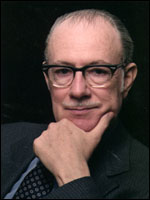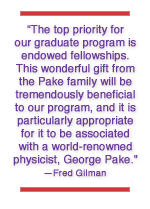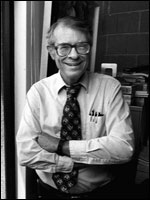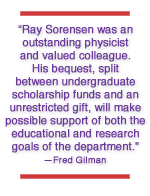|
|
||||||
|
|
Physics Department Receives Bequests of Nearly $1 Million
Carnegie Mellon University's Department of Physics has received two bequests totaling more than $950,000. The department received a gift of more than $550,000 from the estate of the late alumnus and Xerox PARC executive George E. Pake and his wife, Marjorie S. Pake, to financially support doctoral students. A bequest of nearly $400,000 from the family of Raymond A. Sorensen, former head of the Physics Department, will be used to sustain and enhance leading programs in education and research.
"The top priority for our graduate program is endowed fellowships. This wonderful gift from the Pake family will be tremendously beneficial to our program, and it is particularly appropriate for it to be associated with a world-renowned physicist, George Pake," said Buhl Professor of Theoretical Physics Fred Gilman, head of the Physics Department.
The department has about 75 graduate students pursuing research in a range of fields, including high-energy physics, medium-energy physics, astrophysics and condensed-matter physics, as well as interdisciplinary work at the boundaries of chemistry, biology, materials science and engineering. In addition to research, all graduate students assist in teaching undergraduate physics students.
Pake earned bachelor's and master's degrees in physics in 1945 from the Carnegie Institute of Technology and his Ph.D. in physics from Harvard University in 1948. At Harvard and Washington universities, he conducted research that proved foundational to the development of modern magnetic resonance imaging, a widely used medical and scientific research tool. Pake taught physics at Stanford from 1956 to 1962, and then returned to Washington University, where he served as executive vice chancellor, provost and professor of physics.
In 1978, Pake became vice president of research for the Xerox Corporation, and in 1986, he moved to a position as director of the Institute for Research on Learning in Palo Alto, where he developed positive, hands-on learning experiences in science and mathematics for teachers and students. Pake also served on the President's Science Advisory Committee during the Johnson and Nixon administrations.
In 1987, he was honored with the National Medal of Science, the nation's highest scientific honor, for his many contributions.
"Ray Sorensen was an outstanding physicist and valued colleague. His bequest, split between undergraduate scholarship funds and an unrestricted gift, will make possible support of both the educational and research goals of the department," Gilman said.
A native of Wilkinsburg, Sorensen earned his bachelor's degree in physics in 1953 and his Ph.D. in 1958 from the Carnegie Institute of Technology. After a year at the Niels Bohr Institute in Copenhagen and two years at Columbia University in New York City, Sorensen returned to Carnegie Mellon. He was department head form 1980 to 1989. He retired in 1997.
"He took this position with the strong support of the whole department, who knew he was someone who could be trusted to be fair and energetic," said former colleague Lincoln Wolfenstein, Carnegie Mellon professor emeritus of physics.
Leonard Kisslinger, another former colleague and current professor of physics, described Sorensen as one of the most brilliant theorists in this field. In 1969, Sorensen played a key role in forming a collaborative research group of physicists from Carnegie Mellon and the University of Pittsburgh that met weekly. According to Kisslinger, Sorensen's frequent and insightful questions helped guide the research of the other physicists in this group.
After Sorensen's retirement, he and his wife, the late Audrey Sorensen, traveled to Copenhagen, Stockholm and Seattle. In 2001, they moved to California. He died in March at the age of 74.
Carnegie Mellon's Mellon College of Science develops innovative research and educational programs in biological sciences, chemistry, physics, mathematics and several interdisciplinary areas. For more information, visit http://www.cmu.edu/mcs.
Lauren Ward |
||||
|
Carnegie Mellon Home |
||||||

 In 1970, Pake founded and led the Xerox Corporation's Palo Alto Research Center (PARC). He recruited scientists and engineers who developed the laser printer, office networking, the graphical user interface and other cornerstones of contemporary office computing environments. Pake is credited with pioneering a management style at PARC that combined the best of academic and industrial research, development and business practices.
In 1970, Pake founded and led the Xerox Corporation's Palo Alto Research Center (PARC). He recruited scientists and engineers who developed the laser printer, office networking, the graphical user interface and other cornerstones of contemporary office computing environments. Pake is credited with pioneering a management style at PARC that combined the best of academic and industrial research, development and business practices.

 At Carnegie Mellon, Sorensen conducted research in theoretical nuclear physics, was published often in scientific journals, and taught classes at undergraduate and graduate levels. In the mid-1960s, he and Wolfenstein played key roles in launching a new branch of physics—medium-energy physics—that uses particle physics to analyze nuclear structure.
At Carnegie Mellon, Sorensen conducted research in theoretical nuclear physics, was published often in scientific journals, and taught classes at undergraduate and graduate levels. In the mid-1960s, he and Wolfenstein played key roles in launching a new branch of physics—medium-energy physics—that uses particle physics to analyze nuclear structure.